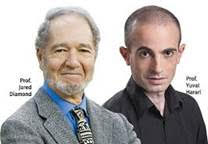Guns, Germs & Steel (A short history of eveyrbody for the last 13,000 years)
Author : Jared Diamond
Genre : Science

There is something about Diamond that makes him the quintessential intellectual (Top 10 Public Intellectuals in multiple surveys). His range of knowledge – molecular physiology, evolutionary biology, biogeography; his depth of scientific evidence to prove or disprove hypotheses; and of course his very interesting writing style and affable persona, all contribute to the lasting impression of his works. Yuval Harari, the famous author of Homo Sapiens, for example, credits Diamond for influencing him.

Guns, Germs and Steel is his most famous book, and instantly won many awards starting with Phi Beta Kappa Award in Science, Pulitzer Prize and then Aventis Prize for Best Science Book. The theme for the book is intriguing. An African acquaintance asked Diamond an innocent question: Why is it that Europe always conquered Africa and not the other way around? Diamond thought the logic could extend to not just Africa but Americas or Australia too: why were the aboriginals there defeated by the Eurasians and not one of those empires ever conquering Europe? Like a good scientist, he is not satisfied by proximate or second factors. We can say Spain defeated the mighty Inca empire (Pizzaro’s 168 Spanish soldiers annihilated 80,000 army of sungod emperor Atahuallpa) because it had firepower, but then why did firepower develop only in Eurasia? More provocatively, he asks, “why didn’t capitalism flourish in New Mexico, mercantilism in sub-saharan Africa, scientific enquiry in China, advance technology in Native America” and so on.

The answer has to go to original causes. He starts with reviewing the sensitive hypothesis of whether Europeans were more intelligent, but then explains through science how this hypothesis is simply not tenable. Instead, after many years of research, his answer is: “History followed different courses for different people because of differences amongst people’s environments, and not because of biological differences amongst people themselves.” His core theory is that geographical conditions favoured the developed of agriculture and domesticated animals in some parts of the world, which meant there was food surplus needed for specialisation like technology development.

To explain these factors, he offers a natural experiment that happened in New Zealand. In 1835, 500 Maori men came in boats to Chatham Islands (hitherto isolated for a thousand years) and completely slaughtered the numerically much larger Morioiri people and took control of their lands. The latter had guns and better technology and so the former did not stand a chance. “The tragedy of the Moriori resembles many other such tragedies…, pitting numerous well equipped people against few ill equipped opponents. But (Maori and Morior)i had diverged from a common origin less than a millennium earlier. Both were Polynesian peoples. A group of Maori colonised the remote Chatham islands and became the Moriori. In the centuries after the two groups separated, they evolved in opposite direction… Maori tropical crops could not grow in the Chatham’s cold climate, and the Moriori had no option but to revert to being hunter gatherers. Since they did not produce crop surpluses available for redistribution or storage, they could not support and feed non hunting craft specialists, armies, bureaucurats and chiefs… With no other accessible islands to colonise, the Morioiri had to remain in Chathams, and to learn how to get along with each other. They did so by renouncing war, and they reduced potential conflicts from overpopulation by castrating some male infants. The result was a small, unwarlike population with simple technology and weapons, and without strong leadership or organization. In contrast… Maori developed locally dense populations chronically engaged in ferocious wars with neighbouring populations. With the crop surpluses that they could grow and store, they fed craft specialists, chiefs and part time soldiers.” Hence when the two met after a thousand years, the outcome of their collision was already sealed!

With the same logic, he explains how some land masses were more suited for domesticated animals. 72 species of large animals are found in Eurasia of which 13 were domesticated. In contrast, of the 51-species found in Africa, only one was domesticable. He explains how a multitude of factors are responsible to make a species ready for domestication. Example, the food chain efficiency is about 10%. Which means if we need 100 tons of a herbivore meat, we need to feed it 1000 tons of corn. In contrast, if we need 100 tons of carnivore meat, we need 1000 tons of herbivore animals (which will be fed to the carnivore being bred in captivity) which in turn will need 10,000 tons of crops. This, amongst other factors like ease of domestication, has meant we do not domesticate carnivores (and not because its meat is not delicious enough!).

Domesticated animals meant a continuous source of protein and also ease of farming. An interesting side ‘benefit’ was the emergence of various germs that moved from these animals to humans. [“The major killers of humanity throughout our recent history – smallpox, flu tuberculosis, malaria, plague, measles and cholera – are infectious diseases that evolved from diseases of animals”]. Which meant that while the first set of humans died as a result of these diseases, the later generations in Eurasia developed a natural immunity. And then, when these Europeans went to uncolonized America for example, they killed more native Americans with these germs than with their guns!

So yes, the more nuanced reasons behind Eurasia’s triumph were the environmental differences between Africa/Latin America and Europe that meant more crops, more domesticated animals, more stability, more specialization, and ultimately, more Guns, Germs and Steel with which to defeat the former. !
The book is a very deep read. There are parts I tend to agree with less. I still think the book underemphasises the role of leaders and events in shaping the history. For example, India and Pakistan had the same environmental factors as per the book, but because of differing political leadership and ideology at the time of partition, have evolved very differently in the last 50 years. Or China, before Mao had a very different development than after Mao. Diamond’s explanation is that these are small aberrations in the large broad strokes of history. To explain why none of the African or Latin American countries thought of colonising Europe, while most of European countries went out to colonise, needs a more basic explanation rooted in these fundamental factors.

Why Read The Book: The question that Jared Diamond seeks to explore is something all thinking humans have often wondered: Why did some parts of the world became the colonisers and others the victim? Such a large question needs a deep rooted answer, and this is one of the few books that attempts to provide that answer.
Goodreads Link: Guns, Germs, and Steel: The Fates of Human Societies by Jared Diamond | Goodreads

 This information will never be shared with third party
This information will never be shared with third party
Very well articulated 👏👏
Thought provoking, the question does raise many more questions and some wild and free answers to it. Reading the blog was more like time travel. Thank you for sharing such a wonderful piece of literature😊